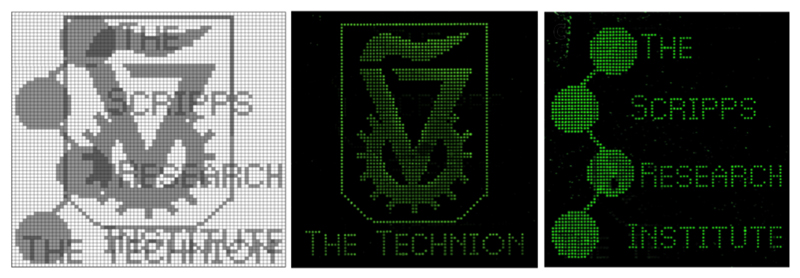Biological computer encrypts and deciphers images
February 8, 2012

Scientists have developed a “biological computer” capable of deciphering images encrypted on DNA chips. As a proof of concept, the scientists encrypted the Scripps Research and Technion logos on a single DNA chip and, using software, decrypted the separate fluorescent images. (Credit: Keinan lab, Scripps Research)
Scientists at The Scripps Research Institute in California and the Technion — Israel Institute of Technology — have developed a “biological computer” made entirely from biomolecules that is capable of deciphering images encrypted on DNA chips.
This is the first experimental demonstration of a molecular cryptosystem for images based on DNA computing.
When suitable software was applied to the biological computer, it could decrypt, separately, fluorescent images of The Scripps Research Institute and Technion logos.
The hardware and software in these devices, Keinan notes, are complex biological molecules that activate one another to carry out some predetermined chemical work. The input is a molecule that undergoes specific, predetermined changes, following a specific set of rules (software), and the output of this chemical computation process is another well-defined molecule.
This computer is “built” by combining chemical components into a solution in a tube. Various small DNA molecules are mixed in solution with selected DNA enzymes and ATP. The latter is used as the energy source of the device.
“Our biological computing device is based on the 75-year-old design by the English mathematician, crypotanalyst, and computer scientist Alan Turing,” Keinan said. “
As shown in this work, he said, a wealth of information can be stored and encrypted in DNA molecules. Although each computing step is slower than the flow of electrons in an electronic computer, the fact that trillions of such chemical steps are done in parallel makes the entire computing process fast. “Considering the fact that current microarray technology allows for printing millions of pixels on a single chip, the numbers of possible images that can be encrypted on such chips is astronomically large,” he said.
“Also, as shown in our previous work and other projects carried out in our lab, these devices can interact directly with biological systems and even with living organisms,” Keinan explained. “No interface is required since all components of molecular computers, including hardware, software, input, and output, are molecules that interact in solution along a cascade of programmable chemical events.”
He adds that because of DNA’s ability to store information, major computer companies have been extremely interested in the development of DNA-based computing systems.
Ref.: Sivan Shoshani, et al., A Molecular Cryptosystem for Images by DNA Computing, Angewandte Chemie, 2012; [DOI:10.1002/anie.201107156]